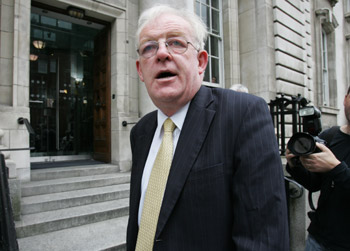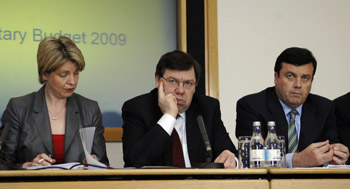Bord Snip doesn’t go far enough

Even if all Colm McCathy's recommended spending cuts were implemented, they would still plug less than a third of the hole in public finances, writes DAN WHITE
19 August 2009
 Fair dues to Colm McCarthy. The king of the hairy-chested economists didn’t disappoint. When he was called upon to draw up a report of possible spending cuts last November his brief was to find €3.5 billion of possible spending reductions. By the time he delivered his report last month McCarthy had found room for €5.3 billion of possible spending cuts.
Fair dues to Colm McCarthy. The king of the hairy-chested economists didn’t disappoint. When he was called upon to draw up a report of possible spending cuts last November his brief was to find €3.5 billion of possible spending reductions. By the time he delivered his report last month McCarthy had found room for €5.3 billion of possible spending cuts.
That’s the good news. The bad news is that the government seems in no hurry to implement any of the politically painful but economically necessary spending cuts recommended by McCarthy. What happened on the day of the publication of the report, 16 July, said it all. The government was nowhere to be seen with McCarthy being left to take all of the flack.
It was as if the plain-speaking McCarthy was the bearer of the political equivalent of swine flu and was to be avoided at all costs. Instead the government headed off on its eight-week long summer holidays just a few days later, delaying any serious consideration of the McCarthy report until the autumn at the earliest. Crisis, what crisis?
This means that even if a significant proportion of McCarthy’s recommendations end up being implemented it will be next year before they have any significant impact on the public finances.
Not far enough
However, even if this government surprises us all by suddenly growing a fiscal backbone, the bad news is that McCarthy doesn’t go far enough, not by a long shot.
This year the government will struggle to raise €34 billion in tax revenues. This is despite raising a total of €6.8 billion in new taxes in its October 2008 and April 2009 budgets. This will be the lowest tax take since 2003.
With unemployment exploding total public spending this year is likely to be in the €56 to €57 billion region. This means that the government will have to borrow €22 to €23 billion to fund its day-to-day activities, plus the €11 billion it has agreed to pump into the banks. There is also the unquantifiable cost of NAMA which is proposing to buy up to €90 billion of bad loans from the banks.
While it could be argued that the €11 billion which is going to recapitalise AIB, Bank of Ireland and Anglo Irish Bank and the cost of NAMA are once-off items the same can’t be said of the €22 to €23 billion gap between tax revenue and non-emergency public spending.
While some of the enormous gap between taxation revenue and public spending will disappear when the economy finally recovers, a large part of it is structural. In other words, unless drastic action is taken government borrowing will continue and the national debt, which has almost doubled to €65 billion over the past two years, will increase exponentially in the years ahead.
Mind the gap
So how much of the gap between taxation and spending is structural rather than cyclical? The peak year for taxation revenue in this country was 2006 when the exchequer pulled in over €47 billion. However, an estimated €10 billion of this was property and construction-related including stamp duty, capital gains tax, VAT on new houses, corporation tax from builders and property developers, and PAYE paid by building workers.
2006 was also the peak year for the construction industry when it accounted for an incredible 23% of national economic output. No less than 15% of this was accounted for by the house-building sector, reflecting the record 93,000 new houses and apartments built that year.
This year and for the foreseeable future annual housing output is likely to be little more than 20,000 new houses and apartments, just a quarter of peak output levels. At a stroke this knocks 11 to 12% off national economic output. Elsewhere in the construction sector the 5% a year of total economic output that the government is currently spending on new roads, schools and hospitals will probably halve over the next few years while the 3% of national output that was going on building new shopping centres, factories and office blocks has most likely disappeared for at least a decade.
Add it all up and the bursting of the property bubble has knocked at least a sixth off likely economic output and tax revenues for the foreseeable future. And that’s not counting the secondary effects in other sectors such as banking and retailing.
Even when the new taxes already raised and the likely re-introduction of a household property tax are taken into account it is hard to see how revenues can rise much above €40 billion even if the economy recovers strongly.
That still leaves a gap of somewhere between €15 and €17 billion in the public finances which can’t be blamed on the recession. No, the villain of the piece is the fiscal incontinence of our politicians. Just one figure tells us what we need to know. The last time tax revenues were at their current levels was way back in 2003. Public spending that year was just €34 billion.
Public spending grows by two thirds in six years
This means that public spending has grown by a massive 65% over the past six years. That works out at an average annual rate of increase of almost 9%, which is utterly unsustainable. This makes it clear that public spending would have had to be cut back, even it the good times had continued to roll.
But of course the good times have long since ceased to roll. The most recent forecasts from the Central Bank estimate that the economy will shrink by 9.4% this year and by further 3.5% next year. This means that, when last year’s 3% contraction is taken into account the economy will have shrunk by a gut-wrenching 16% by the end of next year. That’s not a recession, it’s a full-blown 1930s-style depression.
Economic meltdown will force the hard decisions which the government has so far avoided. The underlying 35% increase in public sector numbers to 373,000 since 1997 will have to be reversed and the fact that average pubic sector wage rates are 47% ahead of those in the private sector will also have to be addressed.
Social welfare payments will also have to be reduced and by much more than the 5% recommended by McCarthy. With the numbers on the live register set to exceed 500.000 shortly, a system which pays out benefits almost three times higher than those in the UK is simply not sustainable.
Unless or until these difficult issues are grasped this country is on a one-way journey to national bankruptcy, even if all of the McCarthy cuts are implemented.



 Print
Print






Fans 0
Followers